We here at GunsAmerica can get pretty passionate about the blades in our pockets or on our hips. And why should that be a surprise? Our knives are utilitarian tools and backup defensive weapons. I’ve been carrying a gun for years, but I grew up with knives. I began EDC of a pocket knife when I earned the rank of Eagle Scout at age 13. I didn’t give a shit that my middle school and high school didn’t allow knives. I simply kept it concealed and stayed out of trouble.
As a devotee of all things cutting edge, I really enjoy knife reviews. But to what end? Odds are very few of us will ever take a fixed blade knife to the point of failure. And the nicest knives on the market these days cost more than some guns, and even though they’re built to withstand the Apocalypse, they never leave their original boxes, and stay safely tucked up in the safe.
Well to hell with the safe queens. We’re on a quest for an honest working knife–a one blade solution to a lot of typical knife issues. I began the work for this last year, with a preliminary list of contenders. The tests were hardly scientific. Even so, I’ve eliminated almost all of the ones on the first list.
But first, the backstory
In our original post, I talked about a Marine and his experience with big knives. I’ll sum it up here; big knives are heavy. Heavy is bad when you carry your own gear. Big, heavy knives get tossed aside. If that was the only knife you had, you’re naked. And worse, someone else (perhaps an enemy) will pick it up.
I wanted to try it out, anyhow–so I put a couple of my favorite big knives in the mix. These were the knives I had on hand to work with. Like these two:
[full_width]
[/full_width]
OKC makes great knives. This one is ideal for camp work. There’s a lot of blade to work with. And, as big knives go, it isn’t as heavy as it could be. This one is my current go-to in the truck. It is on the side of the bag I only carry from the house to the truck to the cabin, etc.
[full_width]
[/full_width]
Bark River makes some exquisite blades. There are serious collectors, too, that would hyperventilate when they see I’ve removed this one from its original box. I’ve even used this one as I would–gasp–an ax. And it works great. But damn, is this thing heavy.
The results of the big knife theory? They chop exceptionally well. They are easy to see, visually, and very intimidating. Their width allows for them to withstand a ton of abuse. And an exceptionally well-tempered blade is all but indestructible. But they’re heavy. They are, for almost everything you do in the woods, overkill. And even when chopping–the one thing that they truly do well–they don’t chop as well as a good hatchet or a sharp machete.
So why are there so many devoted fans of giant fixed blade knives? I called up Jacob Epstein, GunsAmerica’s Tactical Editor, and I asked him about a knife I’d seen on his vest–a monster Fox Tactical behemoth that weighed more than three pounds.
“Yeah,” he said, laughing. “I sold it.” Epstein had figured it out, too, just from basic training work at the range. Bigger isn’t always better. What’s the equivalent in the gun world? There are obvious parallels. I know a lot of folks who have bought guns that were too big to carry concealed–even though that was the reason why they bought the gun in the first place. It stays at home, or in the car, and isn’t there when needed.
The original line-up.
[one_half]
[/one_half][one_half_last]
[/one_half_last]
As it turned out, when I began this quest, I didn’t have a medium sized fixed blade that wasn’t in service in the kitchen. I had several knives in the 7″ range (like the old Ka-Bar). And I was able to beg and borrow these, with an eye toward testing.
From left to right, the knives:
1. Ka-Bar Becker BK-10. This knife is heavier than most, but exceptionally well balanced. There’s a cult following that has developed around this knife. I picked this one up at the Blade Show last year. It is a cosmetic blemish but works exceptionally well. This is the one knife from this line-up that has made it into the second phase of testing. $117.
2. SOG Jungle Cutlas. This is a kick-ass heavy chopper. And for car camping, or tasks around the cabin, the rubber handle and stainless blade make this a true workhorse. I dearly love the knife, but I’m not going to carry it far if I have to carry my own gear. It isn’t a hiking knife. $70.
3. Ontario OKC 3s Bayonet. Is the bayonet anachronistic? I asked for this one early because I’d hoped to see something in the American issued gear that seemed logical and would support the large knife. There is a belief held by some knife designers, that the blade of a fighting knife needs to be 7″ long to strike vital organs in humans. To that end, this works. But I don’t even own a rifle that can take a bayonet anymore. And if I can’t put it on a gun, it is a knife–not a bayonet. $184.
4. Browning Black Label Rail System Knife. The pig sticker design is great for sticking small pigs. And The Fairbairn-Sykes design is a great second knife. But the tang is weak, there’s no heft to the blade, while it is optimal for stabbing, it doesn’t do anything else. Actually, that’s not true. This knife’s sheath is designed to attach to a piccatinny rail. It does that exceptionally well, if that’s something you’re looking for. But for our purposes here, I’ve scratched it off the list. Price? $74 or so, retail. Hard to find this one anymore.
5. Ontario M9 Bayonet. So if one updated Ontario bayonet doesn’t make the list, odds are the older design won’t either. Again, I’m enamored with the design. I like the feel of the knife. If you were in need of a functional knife, this would work. Yet it has features that simply aren’t useful for my set of criteria. It does have a wire-fence cutter, though, that kicks ass. $172.
6. Browning Black Label Committed. The second Browning knife was included more for its simplicity and price. It has a great sheath–possibly my favorite part of the design. The blade itself is deeply hollow-ground, and it has a serrated edge. Is that good? As long as it stays sharp. Compared to sharpening a flat edge, serrations can be a hassle. In the end, I am putting this on the reserve list. $97.
The refined criteria
After more than six months of focused examination, I’ve made some decisions. Here’s what I’m looking for. I want the perfect knife to put on a tactical vest. I’d like to know that the same knife would be equally at home on my belt, if I were in the shop or out hunting. I’m not looking at any pocket knives for this list–I’ve never seen a pocket knife that’s capable of the abuse you can put good fixed blades through. I’m not saying I don’t like pocket knives–as I mentioned, I’m never without one–but I want something more. So the knife has to be all of these things:
- Fixed Blade
- Appropriate for basic bush-craft
- Capable of fighting
- Not too long (The traditional fighting knife has a 7″ blade)
- Not too short (At least 3″ of blade)
- Not too heavy (This one gets subjective)
- Full tang (for durability of the blade and handle)
- Not delicate in any way
- Readily available
- Easy to clean and sanitize
- Capable of standing up to weather, use, and abuse.
I’m considering several brands, already. I’ve got knives from a variety of price-points. Some of these are fan favorites, and some are more obscure. Ideally, I’d like to support America labor but when we get into pricing, we may make some allowances.
The new short list
[full_width]
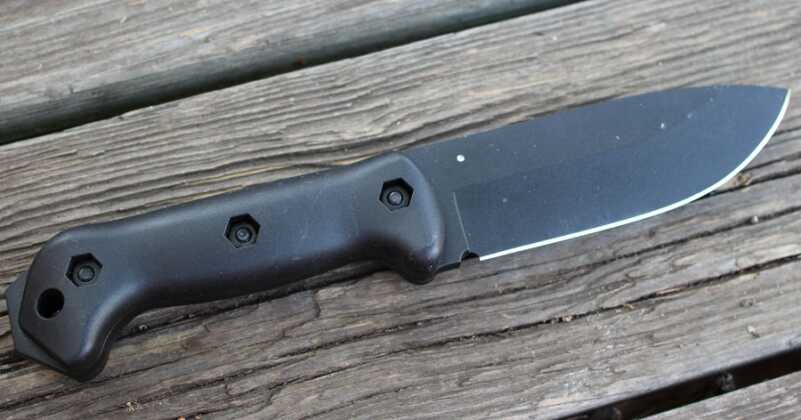
The Becker is still in the running.
[/full_width]
The strength of the Becker? It has a compact design with a fat blade. Excellent strength. And a huge cult following means there are a lot of available modifications. We’ll be looking at how the blade arrives from Ka-Bar, and what the every one does to it. This is the AR-15 of the knife world.
[full_width]

I’ve added the 4″ Esee.
[/full_width]
The Esee knives have an equally devoted fan base. They are thinner and more nimble than the Beckers. If you are looking for the ideal balance between weight and performance, this might be it.
[full_width]
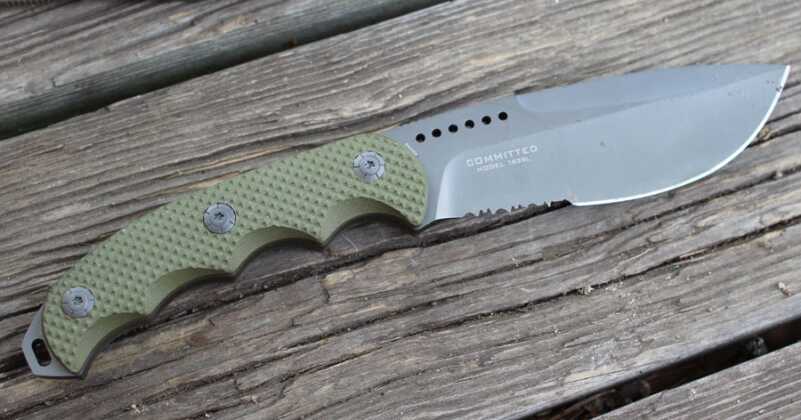
The Committed is still on the list.
[/full_width]
For those who like a combination blade, and one that has a fat belly for skinning and such, the Committed is a decent option. The grip is also very easy to hold onto thanks to the finger groves. I like the sheath it comes with, too.
[full_width]
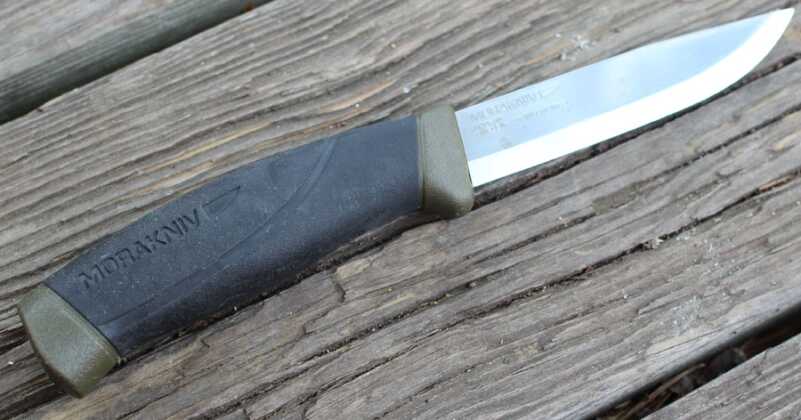
This Morakniv is a great option, and a real value, too.
[/full_width]
A friend bought me this knife a few years ago, and it sees regular service in my kitchen. I love the Scandi grind on the blade. It is exceptionally sharp and has stood up to regular trips through the dishwasher. And it is stupid cheap. I’ve yet to see inside the handle, though, so I’m not sure about strength.
[full_width]
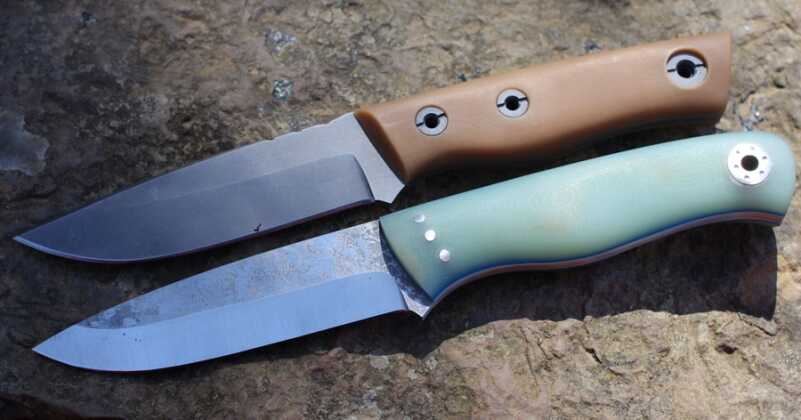
What would the knife look like if I had it designed from the ground up? Fall Creek Knives is here to answer that question.
[/full_width]
As I began to narrow down my list of criteria, I talked with several custom knife makers about the concept. I’ve made knives myself, both by means of forging and stock reduction, so I’m not clueless when it comes to metallurgy and technique. I’m also not an expert, so I figured I’d talk to one. Shannon Carter at Fall Creek Knives was kind enough to answer my questions and he’s worked with me on this pair above–the customized answer to the question. Stay tuned for the complete review.
And this is where you come in. Look at my list above and make some suggestions. This is an ongoing project. What knives should make the short list? What would you expect a general purpose knife to be able to do? Respond in the comments below.
Want to read more about the folders we’ve been working out, click here.


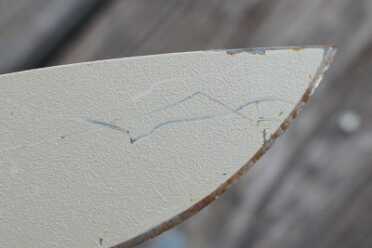


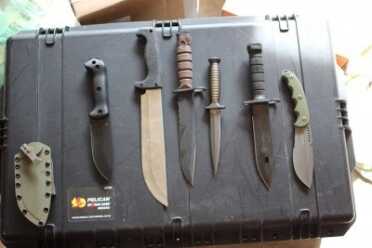
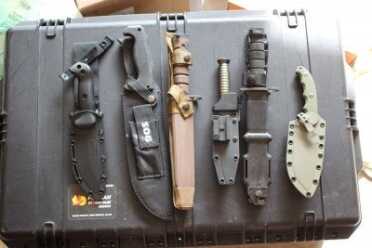
Well done article but really doesn’t mean much in the greater schema of blade usage. Which is more subjective than anything else considering the various specific uses for knives where some perform much better for the intent, and others can do a couple more uses reasonably well also, and others are only good for one specialty purpose. And then just about al blades can be ‘weaponized’ to various degrees but some, especially in the hands of skilled handlers, make a much more advantaged killing tool.
So to say that one can find a ‘one knife that can do it all’, is like saying there’s one car that can do it all. Which there ain’t, and never will be. About the best you can do is have multiple kinds of knives that fit everything you need.
In the green hell days those of us in remote basecamps doing exploring outside the secure perimeter always carried short but heavy machetes. Mostly for hacking trails and dispatching snakes. I had mine in a scabbard to the side of my ruck or just in a shoulder sling if traveling light for a fast draw over the top by reaching slowly passed my right ear over my shoulder, drawing and swinging at the same time down to a target. Some of us got quite good at this and could whack the head off a snake slithering down from the trees faster than the snakes could wind up and strike. I found mine buried in an old box not long ago after forgetting about it for decades and almost blew a house circuit breaker with all the flashback energy it brought back. The old bamboo handle was almost missing completely and a small deflection hit from a small bullet or shrapnel. But at about seventeen inches total length with a modified angular bolo shape drop point tip about 3-4 inches at widest point and around 1/4″ thick ,with a full tang handle that you could squeeze two normal adult hands on, like a short Katana sword for double chop power if you had to, But this wasn’t just a weed whacker doing side work as an amateur ‘Gladius’ replica. With some practice it would easily excel at thrusting and slashing with enough one shot momentum to end any fight, likely permanently. While at the same time it could handle just about any survival camp chore you need. It wasn’t a standard issue machete and I first thought it might have been originally a native butcher shop tool. because it had a hole near the tip for hanging it up in a shop? But then I saw some natives carrying them by a quick release shoulder snap line through that hole under their armpit for a type of ‘convenient quick draw’ for every day use.
And don’t forget the standard time and tested bowie length knives. 8-10 inches. Its not by accident that they settled on that length of a blade, That Bowie length and a heft and balance suitable to better ‘chop/slashing’ is really not any less ‘unwieldly’ compared to a seven inch blade which is supposed to be the best length today? But will give you a major advantage in single slash stopping power and fast lethal thrusts over a lighter 7 inch blade.
I’ve got some Bowies in my collection worth thousands but my favorite ‘slash and smash’ Bowie I play with and always keep in the truck is a one from China (embarassingly) that impresses me so much (even as a knife fighting instructor and knife throwing competitor) That I can’t believe it. Total length is 14 inches with a 9.25 blade in a straight spear shaped hollow ground drop point just a little wider at the first quarter of the blade near the tip. It’s one of the best balanced fighting knives I’ve ever handled. And it even looks great with a nice polished wood handle and heavy brass polished flush rivets with it’s 3/8″ main thickness before taper being strong enough to break bricks and bend copper pipes without missing a slice, I only regret I bought only three of these at Tractor Supply for 10 bucks each, LOL! In some kind of limited over stock sale like they always have. And I haven’t seen them anywhere else since. The steel looks like basic stainless but it’s thick enough at that length to resist almost all side flex and hard enough to hone a very sharp edge on the expert hollow ground edge cut. It’s even got a saw blade on the top back edge that really cuts because it’ has opposite chain saw type cuts.
Best of all I can even throw this baby by the handle grip in a full power 180 degree non flipping arc out to about 15 feet with penetration that would pretty much be lethal anywhere in body CM.
Although my usual beating around EDC is something like a CRKT spring assisted 4″ blade lock back, but sometimes I carry my $550. out the front 5 inch automatic when I go somewhere where I don’t to be caught in a situation that I can’t either pull my pocket pistol or keep my hand on and ready with an instantly totally concealed ‘pocket’ knife for instant deployment and use.
I don’t think i’d ever need to go with a 5-7 inch fixed blade side knife for EDC or anything. We used to call these ‘hunting knives’. But if you’re not hunting game with a need to field dress and cape, then why imagine it would work better than anything else? But if you could only have one blade in an type of survival emergency, it would have to be some sort of Bowie size blade. Maybe with that little red pocket knife with a spoon in it from Walmart for 10 bucks attached in a secondary sheath pocket on your Bowie knife.
The author has basically remade the Morakniv with better quality and a full tang.
This is not a criticism. I find the mid sized Mora’s to be nearly the perfect every day knife. Remaking it with better quality materials is a brilliant recipe for the perfect every day knife.
Don
The almost perfect go to knife is a cold steel 12″ cutlass bladed machate!! It does not skin deer or alligators well!! Beyond that it will out perform most other knives in any function you choose!! The rest of the good news at a cost of around $20.00 if you don’t like the blade size or shape get a Dremal die grinder & a belt sander & fix it the way you want it!!
my edc fixed blade is the best knife I have ever owned, it splits wood guts deer and has been beat in every way that I have needed it to do. it’s from Sweden, fallkniven S1 pro. laminated vg10 steel fulltang hardness HRC 60 blade thickness 6mm weight 250g. I use my knifes and carry it every day and have yet to destroy it in a gear and a half. I thought I would add my favorite knife to the discussion. David
I have yet to understand why the knife industry continues to dismiss Cold Steel and their products. For your “criteria” about 4 fixed blades come to mind, and that’s without even looking at their catalog. Cold Steel SRK is but one.
And why, after over 20 years of open challenge to the industry, am I unaware of any knife manufacturer or custom knife maker, putting one of their products against Lynn Thompson’s in a public display of cutting, chopping, sharpness and strength?
Things that make you go “hmmm…”
GERBER
Please check out Vulture Equipment Works. Great durable blades the don’t kill your wallet.
I also have found that no ink knife fills all rolls but recently after a 40year search I came across a knife a optics planet that is a smaller full tang stacked leather handle KA-BAR. It’s about two thirds the size of the KA-BAR and has finger grooves and a beautiful thickness to it. It’s got a Browning label on it and the model is the OPMOD. This is a line that Optics Planet and Dvor run. It even has a nice K that’s chief with the unique lock system for the boat retainer or loop systems. This life is become a favorite of mine in the woods around camp around my house is an every day carry even though it’s not legal in my area. I can’t remember what the Steelers but it is parked her eyes and the Pall Mall and Ferrell are aluminum. It seems to keep Edrie markedly well Even with the beatings I put it through because I don’t have to sharpen it but every month to six weeks on average low for caping an Elk and breaking it down I had to sharpen it twice this season I also use the knife at least daily for something The only problem I have with the entire system and knife is that the blade itself is marked made in China. You would think Browning would at least have their knives made in the US
I carry the case xx version of the U.S.M.C. combat knife,it’s carbon steel so no problem useing the back side as a striker for a fire starter and it’s all U.S.A. made. It holds a edge well and it is easy to keep razor sharp.
The big-knifed Marine you spoke of must be a modern desert-war warrior. In Vietnam, nearly every
Army paratrooper I served with carried a BIG knife to hack his way through the jungle. Usually,
It was a Case Western Bowie. No one threw away their knives, and they carried their knives in addition
to heavy rucksacks and full battle gear. If in a battle, after expending 400 rounds of ammo and 4 fragmentation grenades one found himself only armed with a knife (it never happened to me), he’s as good as dead no matter
What kind of knife he had.
Keep the Mora. If you don’t mistreat a rat-tailed knife blade (this is what the Moras are – for pics look at https://www.ragweedforge.com/BladeCatalog.html and scroll down to the bare Mora blades), they are fine. If you do mistreat them, well, they’re only about $12 or so – buy a few spares. You can buy nearly a dozen Moras for the price of a single ESEE knife.
Someday, Mora will probably make a nice full tang knife. I imagine it might cost as much as $20, maybe $25. Pricey.
They do. It’s called the garberg and costs 70 bjcks on sale.
I like the Schrade SCHF1 & SCHF9 for fixed blades. For me, nothing gets used more than the Victorinox Swiss Army Knife (Huntsman). Not even the Schrade Tough Tool plier/multi-tool!
I guess I am old school but of the several knives I own if I had to choose one to do it all I would take my air force pilots survival knife. It is a well built solid rugged knife that has a track proven record.
“began EDC of a pocket knife when I earned the rank of Eagle Scout at age 13. I didn’t give a shit that my middle school and high school didn’t allow knives. I simply kept it concealed and stayed out of trouble.”
Mr. Higginbotham, by that statement, you have dishonored yourself. An Eagle Scout maintains honor ALWAYS. very sad.
Had the same thought.
Do not knock the boy for what he did…An Eagle Scout is a “Thinking Scout and always prepared, Honest to himself number one and protective of his neighbors. Kiss my ass pal, lucky I do not live near you to show you how to behave, leave the wiser and harder working class kids alone. I was a scout, right up to the point of being an Eagle Scout and my mother died and I had to quit scouting and go find a full time job. Curly
How could a young fellow dishonor himself by carrying/using a knife in a responsible manner? I think it is a far greater dishonor for the pussies running the school system to try to infringe a God given right. I have carried a pocket knife for over 65 years and yes, there were places they were forbidden. Do I feel bad? Hell, no!
I have also legally carried a gun for nearly 50 years, also in a responsible manner. Today while eating lunch in a national chain restaurant I noticed a sign on the wall saying it is a gun free zone. The owners of that outfit can kiss my keister.
‘Honor’ and ‘blindly following stupid rules’ are not the same thing.
My vote would go to the SURVIVE GSO-5.1 in CPM-3V. Light, but tough enough to handle about anything a knife SHOULD be called on to accomplish.
I don’t believe the knives selected for this review even come close to a fair representation of “what’s out there” as far as “Survival Knives” or even EDC Blades. I don’t see any off shore blades on the list, which whether you care to admit it or not, is what vast majority of people actually end up carrying these days.. Where are the Buck Knives? (the Buck 119 might be the best general purpose blade anybody has ever built) and their sales record proves it.. Where’s Case? Moore Maker? The new Schrade Knives, (although made in China) are actually turning out to be pretty good knives. And Who can beat the prices? When I head off into the boondocks am I grabbing a $300 Safe Queen or am I grabbing the $50 workhorse that won’t break my bank if I break it or drop it down a rabbit hole? These Days, when it come to functionality, there isn’t enough difference between any of them to spit at. So what does it come down to? For Me it’s about Functionality, Affordability, Sharpenability, & Durability. In that order..Aesthetics doesn’t even enter into the equation… I think that holds true for most reasonable people.
For me, the perfect knife means one that fits the – if I could only have one category. When price is factored in, none suit me better than an M4 Bayonet (M1 Carbine). It just feels natural in my hand. Second choice would be a KBAR and third an M7 Bayonet (M16).
It’s smaller and easier to wield than a KBAR, my second favorite or any of the Bowie and machete types. Tougher than any folder, it’s still compact enough to wear or carry in even a fanny pack. Both leather and hard shell sheaths are available which can be either belt worn or attached to military style duty belt.
It has a:
Thick one piece blade/tang
Tough segmented leather oval shaped handle fits almost every hand big or small and will not slip when wet
Heavy steel pommel
Hand guard above and below the blade
Double edged blade with full length sharp edge on bottom side and half length sharp edge on top (allows using top rear of blade for anvil point for hammer when cutting really tough objects and double sided sharp edge cuts when wielded in both directions and the thick double drop point penetrates well.
Double ground edge top and bottom
It’s parkerized for corrosion resistance
It comes sharp when new and is easily sharpened to a tough and sharp edge.
Originals and newly made are both readily available at affordable prices.
Lastly, it can be used as a bayonet on an M-1 Carbine still being manufactured today, of course, which makes a great close range (two hundred yard effective range) semi-auto home or personal defense carbine in a light weight, very low recoil, low flash caliber with the right ammo. For those who don’t like the bayonet ring on top of the hand guard, that is easily cut off or modified at any metal working shop or at home with the proper equipment. A standard .30 carbine ball bullet weighs 110 grains (7.1 g), a complete loaded round weighs 195 grains (12.6 g)and has a muzzle velocity of 1,990 ft/s (610 m/s) giving it 967 ft·lbf (1,311 joules) of energy.
And by the way, the straight walled .30 cartridge casings are like pistol rounds easy to load/reload and the bullets are easy to find. Commercial ammo in new high tech self defense type ammo is available.
Busse DSSF
Great utility knife with a dash of fighter built in. I’ve modified mine to make it a little more of a fighter, by adding a guard and small sharpened swedge at the tip, but it still retains its utility.
I would strongly recommend the following knives as I have put them through REDICULOUS stress, some of these maybe slightly heavier or more expensive than what you’re looking for but I believe they offer the MOST versatile use for their weight, in no particular order.
1. Ka-bar Snody Big Boss
(S35VN steel, very stainless while being league’s tougher than the 440 series with significant lateral stregth over S30V steel (it’s precurser), decent width for strength, good height for weak hand control and combat applications, holds a great edge, has after market handle scales available. 4.5 in blade I believe. CRAPPY SHEATH).
2. Ka-bar Dogs Head Utility Knife.
(1095CV steel, all the pluses of the original kabar fighter but with a more compact 5.25 inch blade, which I have found to make the knife immensely stronger laterally, pommel makes a great hammer, edge retention is great, ease of sharpening, I’ve used this knife to pry 6x6s apart and lift HVAC units, sheath options)
3. Esee 5 w/ partial serrations
(1095 steel, EXCELLENT HEAT TREAT, 5 inch blade, this knife while definitely the heaviest at 1lb is by far the strongest most durable production 1095 knife I have ever used, I carry this knife as my edc and use it extensively at work as a prybar, chopper, cutter, even a climbing aid. I’ve cut every material from rope and nylon to insulation with steel wire in it, cut down small trees, batoned logs, skinned a large buck, pryed doors open, busted glass, even used the pommel to chip out cinder blocks. This knife with the upgraded locking kydex sheath is the knife, regardless of weight that I never go ANYWHERE without.)
4. Ontario Rat 5
(All in all a great lighter alternative to the Esee 5 with the sacrafice of lateral strength and chopping ability, but also a faster more nimble blade.)
5. Schrade Sch42 Griffith Design
(1095 steel, 5 inch blade, this is definitely the budget blade but it is a work horse! Good leather sheath, .25 inch spine flare ground down to a secondary bevel, decent recurve adds to the ability to chop without adding weight, batons wood like a beast, great utility knife, not a great knife to pry or load bear with like the other 1095 knives. MUST PUT NEW HANDLE SCALES ON IT.)
6. Steel Will Cager 1410
(D2 steel, 4.33 inch blade, great solid knife, kydex sheath, being the thinnest knife on the list it is the best slicer, and would make for the best combat knife due to its semistainless nature and light weight, it has handled all my testing excellently minus lateral strength but it obviously isn’t designed as an entry tool. Also it needed the least amount of maintenance due to the semistainless and high hardness.)
There are TONS of knives I haveN’T tried it even seen I’m sure but these knives in my expirence will do what your looking for while all of them being able to be purchased for LESS THAN $150
Full tang knives with the scales attached to the sides of the tang can work loose. I’ve done it with my favorite kukui by heavy chopping a dead 8″ Dogwood that had dried out over the course of several years. The scales were riveted to the tang and glued too. The scales are Rosewood and the rivets were aluminum. I drilled the tang for new steel pins and reglued the scales and rivets. I think a rat tail tang like on the M series bayonets is a better option.
Dump the Mora. Not a full tang, in a plastic handle. I broke a handle clean off with a little tap of a mallet when a blade got buried in a log I was splitting. Got for a kid’s first knife, that’s about it. Cheap is as cheap does.
NO perfect knife quest is complete without including a Busse with Infiniti steel. Nothing tougher. You ha e to be patient to get one that you like new, or go to various forums. I use mine, not a safe queen. I prefer less blade length, in the 4-5″ range.
There are no Eagles ready at 13 or even 14. There isn’t enough maturity and experience. We have boys that come back from NYLT [National Youth Leadership Training] each year livid about the kids from ‘Eagle mills’ that don’t have the basic skills to set up a tent or start a fire or cook a meal, let alone show any leadership.
Esee Laserstrike
Becker BK7
Tops Mil-Spie 3
Take a look at the Boker Arbolito. The blade is well designed, holds an edge well and is brutally strong. The handle feels good in your hand as well and the tapered tang lightens the weight as well as improving the balance. The one negative is that Boker does not have a clue when it comes to a useful sheath. I am still on the hunt for a useful sheath for every day use, but the knife is a definite keeper.
Do not overlook any of the TOPS Knives! They have awesome USA made blades.
Tops knives for sure. I have three of these and love all three, but the C.U.B is my favorite. I also have the standard size Tom Brown Tracker and the large heavy one. Great knives but their sheaths (especially the C.U.B sheath) need help I think, but then I am a leather sheath guy so go figure. The knives are solid for their sizes. Great steel. I have been called a knife nut, which is a proud mantle to me.
Good article about different style fixed blade knives. However, the metal selected for the various blades was not discussed. Perhaps your ongoing research will include such information later.
Some knife metals are very tough, while others keep a sharp edge for a long time between sharpening. I don’t regard a knife as being a pry-bar so I reserve its use for severing, whatever. There is one metal that can hold its edge longer than any other, namely the Crucible particle metal called S90CM. This is the new name for what was once called 154CM.
This metal has three drawbacks. 1) It is rather expensive, 2) it is difficult to fashion into a knife, and 3) it must be sharpened with either a diamond or ceramic sharpening tool. This metal defies files and all of the common sharpening stones such as Arkansas and the Japanese wet stones. If you need to carry something for prying or chopping, get one of those tools for opening packing crates that have a hatchet head welded onto a short pry bar. If you want a knife to stay scary sharp long after other knives need resharpening, find a knife maker that uses the Crucible Particle Metal called S90CM.
Oh yeah, make sure that you carry a diamond or ceramic sharpening accessory with your new knife made of S90CM. You won’t need to sharpen it as often as other blade metal but when it does need it, forget carborundum. If you try to use anything but diamond or ceramic, you will swear that the knife is laughing at you.
154CM is not anymore difficult to sharpen than any other high wear resistant steel if it has been properly heat treated, and there in lies the rub. 154CM is the American answer to Japanese ATS-34. Chemically, they are almost identical. 154CM was originally developed for the U.S. Navy as Bearing Steel for the large propellers found on Navy Submarines and Surface Vessels. It’s ability to stand up to salt water corrosion and it’s high wear resistance properties make it an ideal platform for large surface area bearings… It contains a relatively high amounts of vanadium & chromium, which is where it get’s it’s wear resistant properties. As such it requires special heat treating protocols which can be difficult to maintain in high volume ventures such as blade steel. It can make for an excellent cutlery platform. That being said, it is not ideal. What 154CM gains in wear resistance, it gives up in sharpness. This is true of all high vanadium/chromium steel. This is due to the any given Steel’s ability to transform from pearlite to austenite structure while under forging temperatures. To make 154CM suitable for cutting, it needs to be soaked at appropriate tempering heat for many hours to allow the steel to relax. Most Knife Makers do not take the time or have the facilities to accomplish this. When I as making knives for a living all my 154CM was tempered 850 degrees in a digitally controlled Kiln for 1 hour per every .010 of thickness and then allowed to cool at 100 degrees per hour. The result is an RC58, which most people that actually know agree is a perfect balance between sharpenability and durability. The old standby of heating to non magnetic critical temperature and dunking in warm oil and then tempering by oxidation coloration simply does not apply to Steel’s like 154CM. If You have one of these knives and have a hard time sharpening it, it’s probably not your fault. The issue lies with the people that built the knife. It’s also a pretty good gauge as to how much the Company you purchased the knife from know about what they are doing.
Could probably rule out #4., as the Fairbairn-Sykes design might not meet the criteria of, “Appropriate for basic bush-craft.”
I think there are better designs than a bayonet for the criteria of the, “one knife,” like A.G. Russell’s Sandbox Bowie (a good Bowie has long been the, “one knife”), and others from, TOPs, Hazen, Entrek, etc.
Your best 3 options from the commercial market are:
#1: Cold Steel SRK in VG-1 (San Mai III)
#2: Fallkniven A1 (a bit heavier than the SRK, better “chopper”, also VG-1)
#3: Ontario Blackbird SK-5 (154CM and very lightweight)
All three can do it all. However, if you have a stronger emphasis on self-defense, the SRK is the hands down winner. If bushcraft is your primary, the A1 or SK-5 are slightly better than the SRK. Personally, judging by your requisites, I’d go SRK.
The only thing that I would have liked to see in this review is the knive’s sheaths. How easy is it to access the knife, get it out of it’s sheath. Also, when putting pictures of knives up, put a reference for measurement with them, like a ruler. My favorite, the ones that I would consider for purchase are the Fall Creek brands. Just based on looking at pictures of them, they look like the right grip, right blade for me. Personally, I’m not too concerned with the carry weight of fixed blade knives. That being said, I’m a fan of the older K-Bar knives. Thier leather handles and heavy edge, to me, are the perfect combination of utility and strength.
When I’m out and about in the field, I really don’t have a payload that is too taxing. Carrying a full size fixed blade on my hip or strapped to my leg isn’t a big deal. I’d rather have a blade that comes closer to a sword than a pocket-knife.